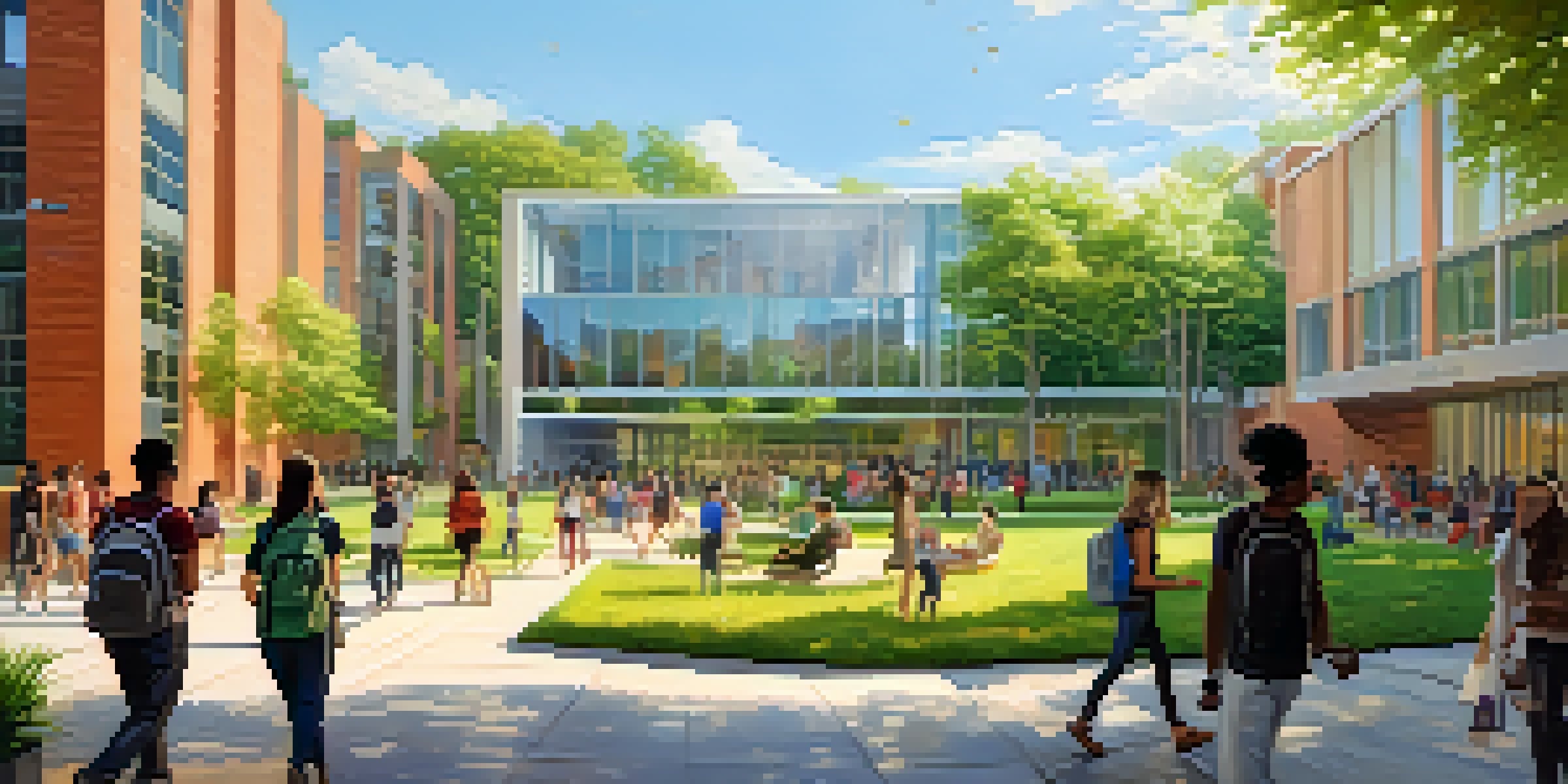The Importance of Education Institutions in Urban Growth

Educational Institutions as Catalysts for Urban Growth
Educational institutions are often the backbone of urban areas, acting as catalysts for growth and development. They attract students, faculty, and staff, which in turn stimulates local economies. The presence of schools and universities can lead to increased demand for housing, retail, and services, creating a vibrant urban landscape.
Education is the most powerful weapon which you can use to change the world.
Moreover, these institutions foster a culture of innovation and entrepreneurship. With research centers and incubators, they provide the necessary resources for startups and established businesses alike. This synergy between education and business helps create jobs and boosts the urban economy, enhancing the overall quality of life.
Ultimately, the growth of educational institutions can lead to improved infrastructure in urban areas. As more people flock to these institutions, cities invest in better transportation, parks, and public spaces, making them more attractive to residents and visitors alike.
The Role of Universities in Workforce Development
Universities play a crucial role in preparing the workforce for the needs of urban economies. They offer a variety of programs that align with local job markets, ensuring that graduates have the skills necessary to thrive. This alignment not only benefits students but also employers seeking qualified candidates.

Furthermore, many universities engage in partnerships with local businesses to provide internships and co-op programs. This hands-on experience equips students with practical skills while allowing businesses to train potential future employees. Such collaborations strengthen the bond between educational institutions and the urban economy.
Education Fuels Urban Economic Growth
Educational institutions stimulate local economies by attracting students and faculty, leading to increased demand for housing and services.
As cities evolve, the demand for specialized skills also changes. Educational institutions must remain adaptable, continuously updating their programs to meet these needs. This ability to pivot quickly is vital for sustaining urban growth and ensuring a prosperous future for both students and cities.
Cultural Enrichment Through Education
Educational institutions contribute significantly to the cultural fabric of urban areas. They host events, lectures, and exhibitions that engage the community and promote cultural exchange. This vibrant cultural scene enriches the lives of residents and makes cities more appealing to newcomers.
The roots of education are bitter, but the fruit is sweet.
Moreover, schools and universities often serve as hubs for artistic and intellectual exploration. They provide platforms for local artists, musicians, and thinkers to showcase their work, fostering a diverse and dynamic urban culture. This not only benefits the local community but also attracts tourism and investment.
Additionally, educational institutions often emphasize the importance of civic engagement and social responsibility. By encouraging students to participate in community service and activism, they cultivate a generation of informed and engaged citizens who contribute positively to urban society.
Innovation and Research Driving Urban Economies
Many educational institutions are at the forefront of research and innovation, making significant contributions to urban economies. Through research initiatives, they address pressing urban challenges, from transportation issues to public health concerns. This research not only benefits the local area but can also have national and global implications.
Furthermore, collaborations between universities and industries lead to technological advancements that drive economic growth. For instance, research conducted at universities often results in patents and startups that provide new products and services, creating jobs and enhancing competitiveness.
Universities Shape the Workforce
By aligning programs with local job markets and providing hands-on experiences, universities prepare graduates with the skills needed by urban employers.
By fostering an environment of creativity and experimentation, educational institutions help cities adapt to changing economic landscapes. This spirit of innovation ensures that urban areas remain vibrant and relevant in a rapidly evolving world.
Accessibility and Equity in Urban Education
Access to quality education is a fundamental aspect of urban growth and equity. Educational institutions play a pivotal role in ensuring that all community members have opportunities for learning and development. By prioritizing inclusivity, they help bridge socioeconomic divides in urban areas.
Moreover, initiatives such as scholarships and outreach programs can assist underrepresented populations in gaining access to higher education. By investing in these communities, educational institutions contribute to a more equitable society, where opportunities are available to all.
As urban areas continue to grow, the focus on equitable education will be essential for sustainable development. By championing diversity and inclusion, educational institutions can help create a thriving urban environment where everyone has the chance to succeed.
Sustainability Initiatives in Educational Institutions
Educational institutions are increasingly prioritizing sustainability as a core value, influencing urban growth in positive ways. Many schools and universities are implementing green practices, from energy-efficient buildings to sustainable campus landscaping. This commitment not only reduces their carbon footprint but also sets an example for the surrounding community.
Additionally, these institutions often incorporate sustainability into their curricula, preparing students to address environmental challenges. By equipping the next generation with knowledge about sustainability, they contribute to a more environmentally conscious urban populace.
Cultural and Community Engagement
Educational institutions enhance urban culture through events and partnerships, fostering a vibrant community and promoting civic engagement.
As cities face pressing environmental issues, the leadership of educational institutions in sustainability efforts can drive significant change. Their influence can encourage local governments and businesses to adopt more sustainable practices, leading to healthier urban environments.
Community Engagement and Partnerships
The relationship between educational institutions and their surrounding communities is vital for urban growth. Schools and universities often engage in partnerships with local organizations, fostering collaboration that benefits everyone involved. These partnerships can lead to community workshops, cultural events, and shared resources, enhancing the urban experience.
Moreover, community engagement initiatives help educational institutions understand the needs and concerns of their neighborhoods. This insight allows them to tailor their programs and services accordingly, making a meaningful impact on local residents. In turn, this strengthens the bond between the institution and the community.

Ultimately, a strong partnership between educational institutions and urban communities lays the groundwork for sustainable growth. By working together, they can create environments that support learning, innovation, and a high quality of life.
Conclusion: The Future of Urban Growth and Education
As we look to the future, the role of educational institutions in urban growth will become increasingly significant. Their ability to adapt to changing societal needs and foster innovation will be crucial for thriving urban environments. By continuing to prioritize accessibility, sustainability, and community engagement, these institutions can lead the way in shaping vibrant cities.
Moreover, as cities continue to evolve, the collaboration between educational institutions, businesses, and local governments will be essential. Together, they can create strategies that address urban challenges and promote economic development, ensuring a prosperous future for all residents.
In conclusion, the importance of educational institutions in urban growth cannot be overstated. They serve as pillars of knowledge, innovation, and community, driving progress and enriching the urban landscape for generations to come.